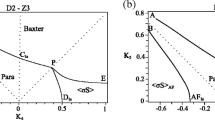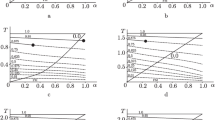Abstract
A procedure, based on exact relations for the spin-spin correlation function and on rigorous correlation inequalities, is presented and used to obtain upper bounds for the critical temperature of the Ising model on the three dimensional pyrochlore lattice. The exact relations for the correlation functions are constructed from clusters of spins that retain the characteristics of the full model


Similar content being viewed by others
References
B.M. McCoy, T.T. Wu. The two-dimensional Ising model (Harvard University Press, 1973)
R. Baxter. Exactly Solved Models in Statistical Mechanics (Dover, 2007)
L. Onsager, Phys. Rev. 65, 117 (1944)
C. Lacroix, P. Mendels, F. Mila. Introduction to Frustated Magnetism: Materials, Experiments, Theory (Springer, 2011)
L. Balents, Nature. 464, 199 (2010)
S.T. Bramwell, M.J. Harris, J. Phys.: Condens. Matter. 10, L215 (1998)
Q. Chen, S.C. Bae, S. Granick, Nature. 469, 381 (2011)
B. Simon, Commun. Math. Phys. 77, 111 (1980)
E. Lieb, Commun. Math. Phys. 77, 127 (1980)
R. Griffiths, J. Math. Phys. 10, 1559 (1969)
G. Sylvester, J. Stat. Phys. 15, 327 (1976)
C. Newman, Z. Wahrscheintichkeitstheorie verw. Gebiete. 33, 75 (1975)
D. Brydges, J. Frólich, T. Spencer, Commun. Math. Phys. 83, 123 (1982)
F.C. Sá Barreto, M. O’Carroll, J. Phys. A. 16, 1035 (1983)
J.L. Monroe, J. Phys. A: Math. Gen. 17, 685 (1984)
G.A. Braga, S.J. Ferreira, F.C. Sá Barreto, Braz. J. Phys. 23, 343 (1993)
G.A. Braga, S.J. Ferreira, F.C. Sá Barreto, J. Stat. Phys. 76, 819 (1994)
F.C. Sá Barreto, A.L. Mota, J. Stat. Mech., P05006 (2012)
S.K. Baek, P.M. H. Makela, B.J. Kim, Phys. Rev. E. 83, 061104 (2011)
J.L. Lebowitz, Phys. Lett. A. 36, 99 (1971)
H.B. Callen, Phys. Lett. 4, 161 (1963)
R. Honmura, T. Kaneyoshi, J. Phys. C. 12, 3979 (1979)
F.Y. Wu, Phys. Rev. E. 81, 061110 (2010)
K. Kanô, S. Naya, Prog Theor. Phys. 10, 158 (1953)
Acknowledgments
GAB was partially supported by the brazilian funding agencies CNPq and FAPEMIG. JPS acknowledges financial support from FAPEMIG-Brazil. FCSB is grateful to CAPES/Brazil for the financial support that made possible his visit to the UFSJ /Brazil.
Author information
Authors and Affiliations
Corresponding author
Appendix Pyrochlore Lattice Calculations
Appendix Pyrochlore Lattice Calculations
1.1 A.1 An Expression for f(a 1, a 2, a 3, a 4)
In this section, we give an explicit representation formula for
where H i is the local Hamiltonian (4) seen as a function of \(a_{i} \equiv J {\sum }_{j=1, 3}S_{ij}\), i = 1, ⋯ , 4. A straightforward computation leads to the identity
Comment: Beyond the single-site cluster theory, the complexity of the algebra rapidly increases and one must thus resort to the use of a computer for the determination of the expansion coefficients on the right hand side of (5). The calculations were developed using an algebraic computation software.
1.2 A.2 Coefficients A n , ⋯ , G n of the Pyrochlore Lattice
To determine the coefficients Λ n ≡ {A n , ⋯ , G n }, appearing in (18), we define,
where f is given by (25) and \(\mathcal {F}\) is a symbolic operation to be specified in the second column of Table 1 for the different multi-spin correlation functions. The operators \(\mathcal {S}_{i}\) and \(\mathcal {C}_{i}\), defined by \(\mathcal {S}_{i}\equiv \sinh (J \nabla _{i})\) and \(\mathcal {C}_{i}\equiv \cosh (J \nabla _{i})\), i = 1, 2, 3, 4, are directly connected to the spin variables appearing in the multi-spin correlation functions in (18).Remark: In (18), each pairing of spins generates a different multi-spin correlation function. This gives rise to a degeneracy and by this word we mean that different k-spin correlation functions have the same coefficient. For example, the spin correlation function 〈S 11 S 12 S 13 S r 〉 has a coefficient B 1, as shown in Table 1, which was obtained from the operation \([(\mathcal {S}_{1}^{3}\mathcal {C}_{2}^{3}\mathcal {C}_{3}^{3}\mathcal {C}_{4}^{3}).f](0,0,0,0)\). There are four spin correlation functions which have the coefficients constructed by the same operation \([(\mathcal {S}_{1}^{3}\mathcal {C}_{2}^{3}\mathcal {C}_{3}^{3}\mathcal {C}_{4}^{3}).f](0,0,0,0)\). This number of identical coefficients is obtained by combinatorial analysis. The degeneracy (λ n ) associated with each coefficient of (18) is given by the numbers \(\sum a_{n}, ..., \sum g_{n}\). For example, for the three coefficients B, the degeneracy is given by,
where p = 3 is the number (k − 1) of the spin variables appearing in the k-spin correlation function, in this case k = 4.
We provide in Table 1 the multi-spin correlation functions 〈S i j ... S r 〉, the generating operators \(\mathcal {F}(\mathcal {S}_{j} \mathcal {C}_{j})\), the associated coefficients Λ n , and the degeneracy of each term λ n , of (18).
1.3 A.3 Correlation functions g 2(J), g 4(J), and g 8(J) of the pyrochlore lattice
The correlation functions of two spin occurring in (19), (21) and (23), denoted by g 2(J), were exactly computed on a finite cluster of seven spins in the pyrochlore lattice, calculated in the cluster constituted by the spins S 1, S 2, S 3, S 4, S 11, S 12, and S 13 (see Fig. 2), i.e, the hamiltonian used in the calculations contains only those spins and their interactions. It is given by,
The four-spin correlation function occurring in (20), denoted by g 4(J), was exactly determined on the limit of an infinite magnetic field applied to all lattice spins except the spins S 1, S 2, S 3, S 4, S 11, S 12, S 13, S 21, and S 22 (see Fig. 2). All other spins of the lattice have been assigned value S = 1. The hamiltonian used in the calculations contains only the above mentioned spins and their interactions. The value of g 4(J) is given by
The eight-spin correlation function occurring in (22), denoted by g 8(J) was exactly determined on the limit of an infinite magnetic field applied to all lattice spins except the spins S 1, S 2, S 3, S 4, S 11, S 12, S 13, S 21, S 22, S 23, S 31, and S 32 (see Fig. 2) with similar comments on the hamiltonian as in the preceding paragraph. The value of g 8(J) is given by
Rights and permissions
About this article
Cite this article
Braga, G.A., Sá Barreto, F.C. & Santos, J.P. Upper Bounds on the Critical Temperature of the Ising Model on the Pyrochlore Lattice. Braz J Phys 45, 64–71 (2015). https://doi.org/10.1007/s13538-014-0296-5
Received:
Published:
Issue Date:
DOI: https://doi.org/10.1007/s13538-014-0296-5




